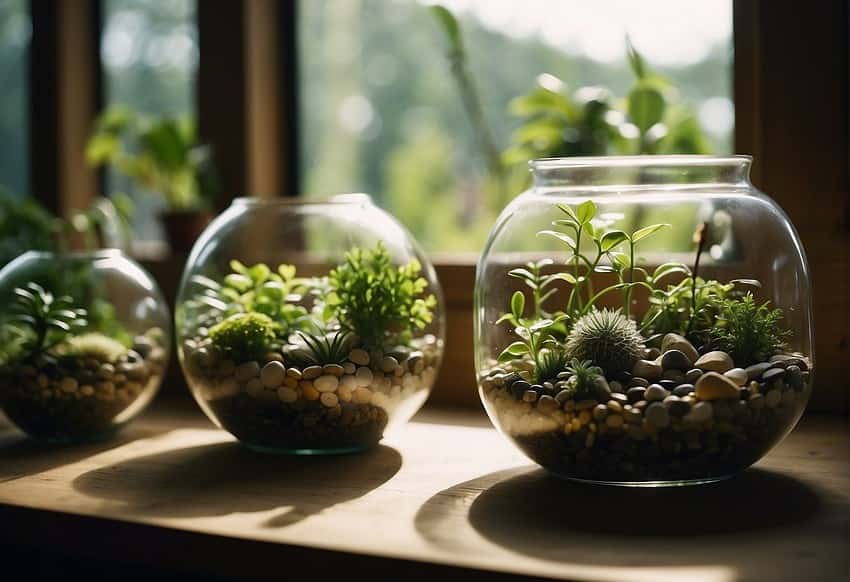Terrariums, featuring Low-Maintenance Terrarium Plants, provide a pocket-sized oasis of nature perfectly tailored to our ever-busy lifestyles. These pint-sized ecosystems encased in glass effortlessly introduce the allure of greenery into living spaces and workplaces, boasting a design that seamlessly combines aesthetics with functionality. Specifically designed for plant enthusiasts facing time constraints, terrariums establish a low-maintenance sanctuary for an array of petite plants. They effortlessly infuse spaces with a sense of tranquility, offering a touch of nature without the demanding care schedules typically associated with traditional gardening.
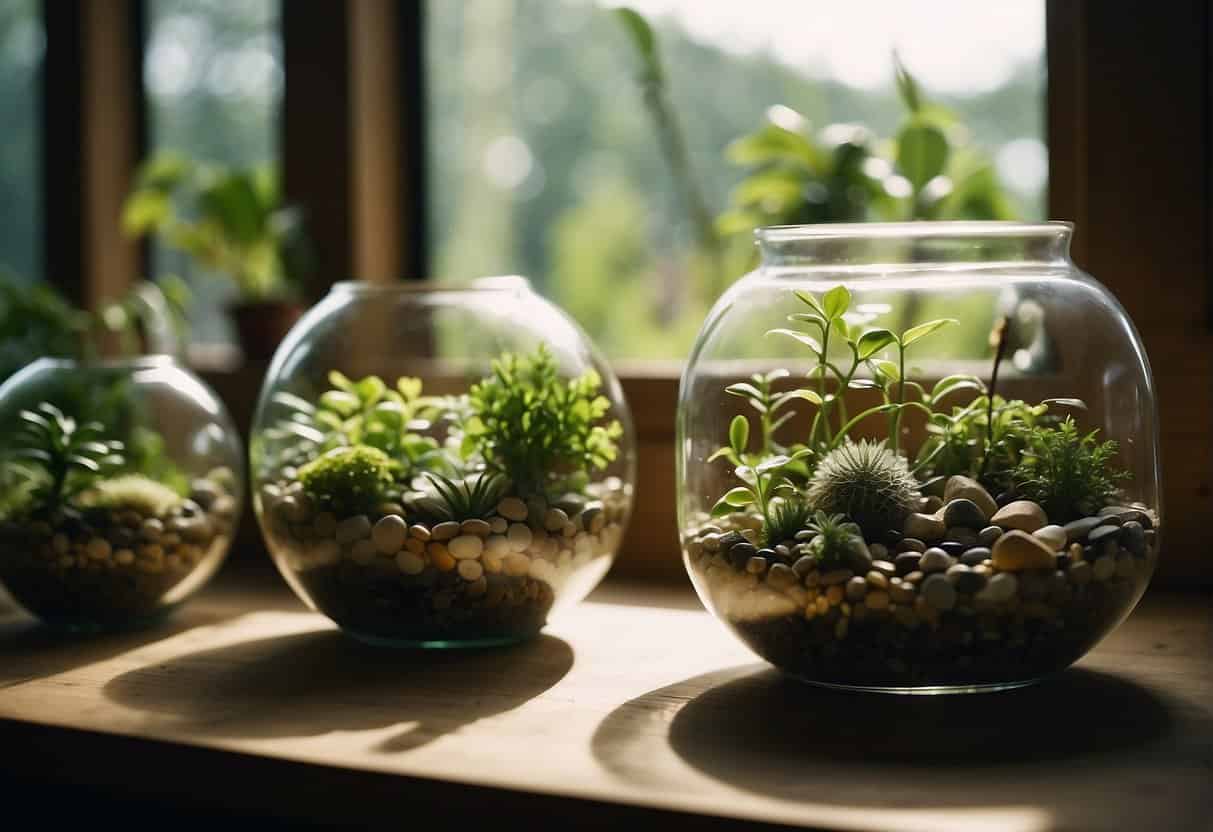
The allure of terrariums lies in their simplicity. They cater to a range of environments, whether it’s the moisture-loving foliage that thrives in a closed terrarium or the drought-tolerant species suited for an open one. Among the best plants for these small-scale gardens are those that demand little in terms of watering, light, and overall maintenance, such as the adaptable pothos or the resilient succulents. For people with busy schedules, these terrarium plants are not just decorative objects but resilient companions that endure alongside them.
Understanding the needs of low-maintenance terrarium plants is key to a thriving miniature garden. Factors such as humidity levels, light exposure, and water requirements are paramount in choosing the right plant for one’s terrarium. By selecting species that are suited to the humid, filtered light conditions typically found within these glass enclosures, even the most time-pressed individual can cultivate a thriving patch of greenery. Embracing terrariums as part of a home or office décor is more than a trend; it’s a sustainable approach to integrating nature into daily life with minimal effort.
Understanding Terrariums
Terrariums are controlled miniature garden ecosystems that can bring a serene patch of nature into any space. They are a stunning way to display plants and create a unique environment where they can thrive with minimal maintenance.
Types of Terrariums
Closed terrariums are typically sealed or have a removable cover, and they create a high-humidity microclimate perfect for moisture-loving plants. Open terrariums, on the other hand, lack cover, allowing for air circulation and suited plants that prefer drier conditions. The choice of containers plays a crucial role, with glass containers being popular for their clear walls, allowing visibility and light penetration.
Benefits of a Terrarium
A terrarium offers numerous advantages, such as requiring less water than traditional potted plants due to their enclosed environment. They also aid in air purification and can be a visually appealing addition to any indoor space, bringing tranquility and the beauty of nature indoors. Terrariums can also be educational, demonstrating the cycle of evaporation, condensation, and precipitation on a small scale.
Essential Components
Creating a stable microclimate for a terrarium involves layering different materials. Soil provides nutrients and support for suitable plants. Pebbles or rocks at the bottom ensure proper drainage, while a layer of charcoal keeps water fresh and prevents mold growth. Sand might be added for aesthetic purposes or to cater to specific plants. Finally, controlling humidity, light, and temperature is vital for the health of the terrarium’s ecosystem.
Selecting the Right Plants
Creating a low-maintenance terrarium begins with choosing plants that are well-suited to your terrarium’s environment. Closed terrariums need species that thrive in high humidity, while open terrariums are better for plants that prefer less moisture and more airflow.
Plants for Closed Terrariums
Closed terrariums create a humid, sheltered ecosystem that favors tropical plants and fern varieties, such as the delicate maidenhair fern. Plants like fittonia are also excellent choices, appreciated for their vibrant leaf patterns and tolerance of high humidity. Additionally, moss types flourish here due to the consistent moisture and the low light conditions inside closed terrariums.
- Ferns: Thrive in the high humidity
- Moss: Loves the consistent moisture
- Tropical foliage: Excel in these conditions
- Fittonia: Offers visual appeal with its bright veins on dark leaves
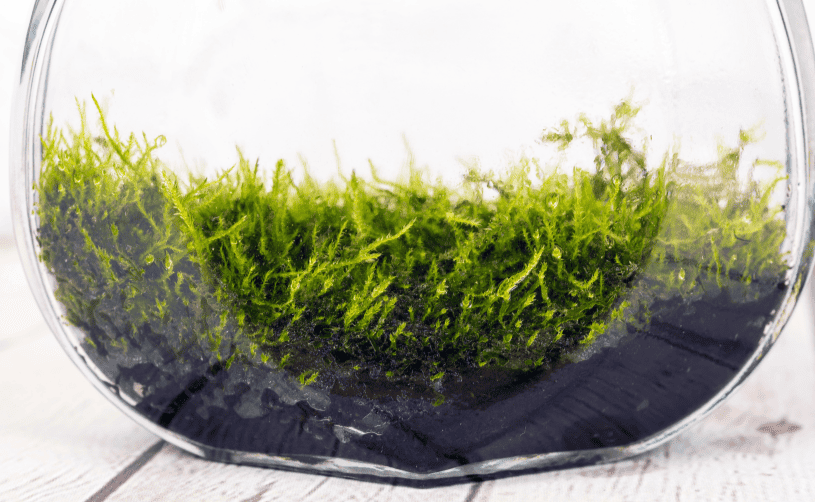
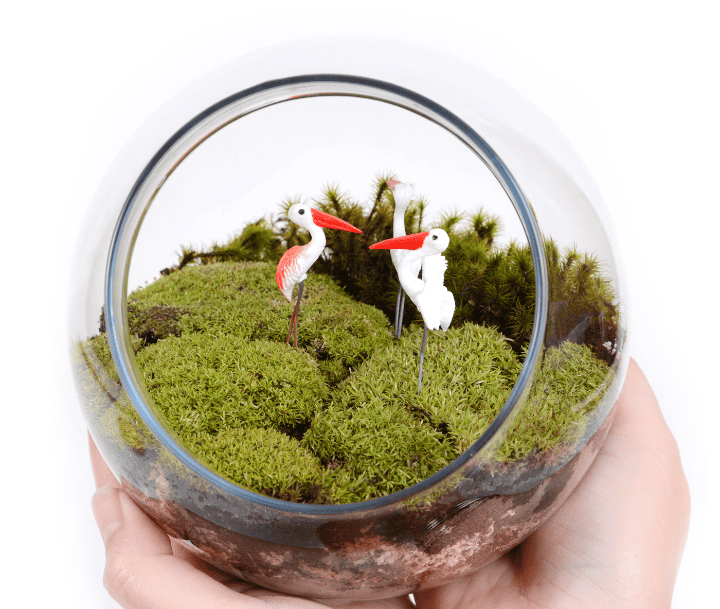

Plants for Open Terrariums
Open terrariums, conversely, are suitable for plants that need less humidity and more air circulation, such as succulents and cacti. These low-maintenance plants require minimal watering, making them perfect for gardeners with busy schedules. Succulent options like echeveria and haworthia are both attractive and easy to care for in these drier environments.
- Succulents: Require minimal watering and care
- Cacti: Well-suited to the low humidity
- Echeveria and Haworthia: Both are aesthetically pleasing and low-maintenance


Considering Growth Habits
When selecting terrarium plants, one should consider their growth habits to prevent future overcrowding. Choose slow-growing plants that require minimal pruning to maintain their form inside the terrarium. Air plants are a prime example as they do not need soil and are easy to control in terms of growth. Lastly, understanding the individual care needs of each plant will ensure that they thrive with minimal intervention.
- Slow-growing plants: Less frequent need for pruning
- Air plants: Do not require soil and grow at a manageable rate
Creating the Perfect Environment
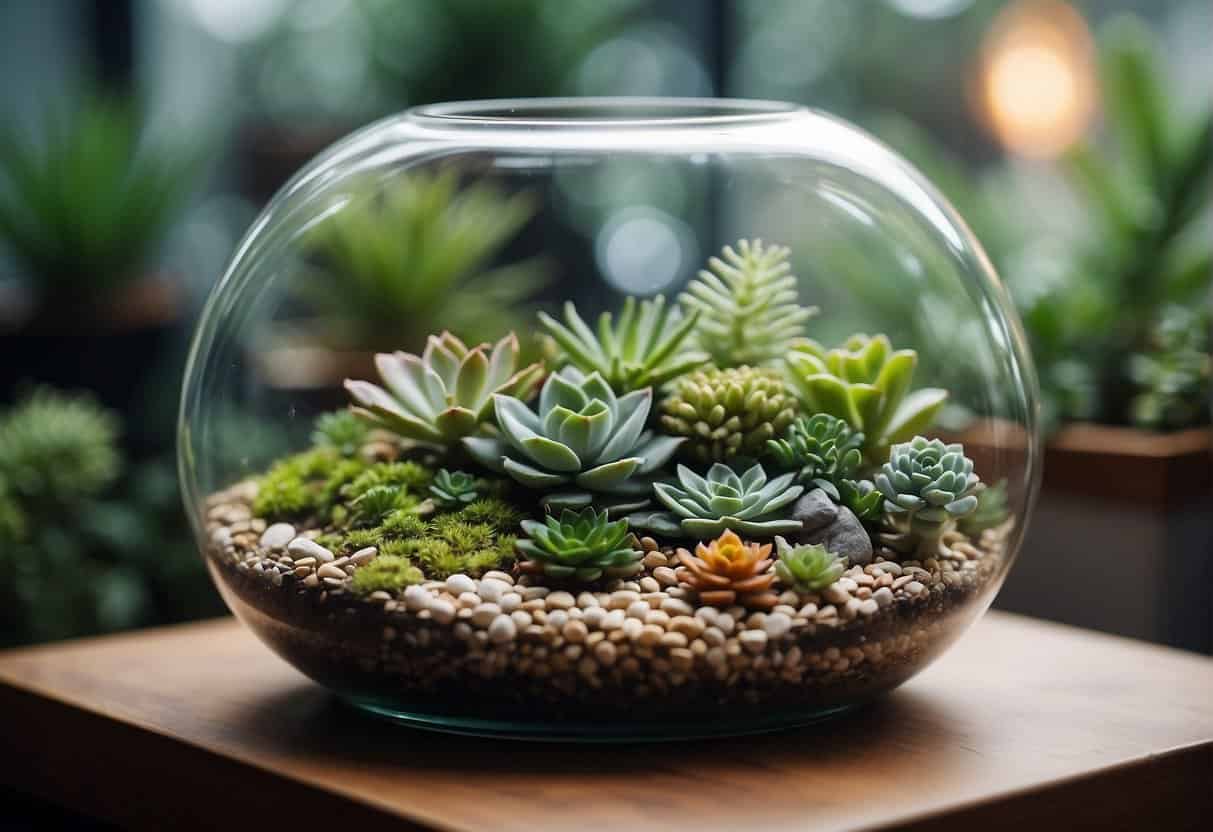
To ensure the success of a terrarium, it’s crucial to regulate the environmental conditions meticulously. Light, humidity, airflow, and soil are the primary factors that will determine the health and growth of your terrarium plants.
Light and Placement
Terrarium plants thrive in indirect light or filtered light conditions. Direct sunlight can be too harsh, often leading to overheated environments that can harm the plants. Placement near a north-facing window or under a grow light ensures the appropriate lighting. For plants requiring low light conditions, avoiding intense afternoon sun is imperative.
Managing Humidity and Airflow
Terrariums typically maintain high humidity levels, which is beneficial for many plants. However, balance is key; too much moisture can lead to mold growth. Ventilation is necessary to provide some fresh air circulation, thus managing humidity levels and preventing stagnation. For closed terrariums, periodically opening them to allow airflow mitigates the risk of mold and mildew.
Soil and Watering Needs
The soil in a terrarium should be well-draining, with components like peat, vermiculite, and sandy soil mixed for moisture regulation. Watering needs are minimal, and the soil should only be moistened when it starts to dry out, with care taken not to overwater. It’s important to monitor the moisture levels regularly to maintain a healthy environment for the terrarium plants.
Designing Your Terrarium
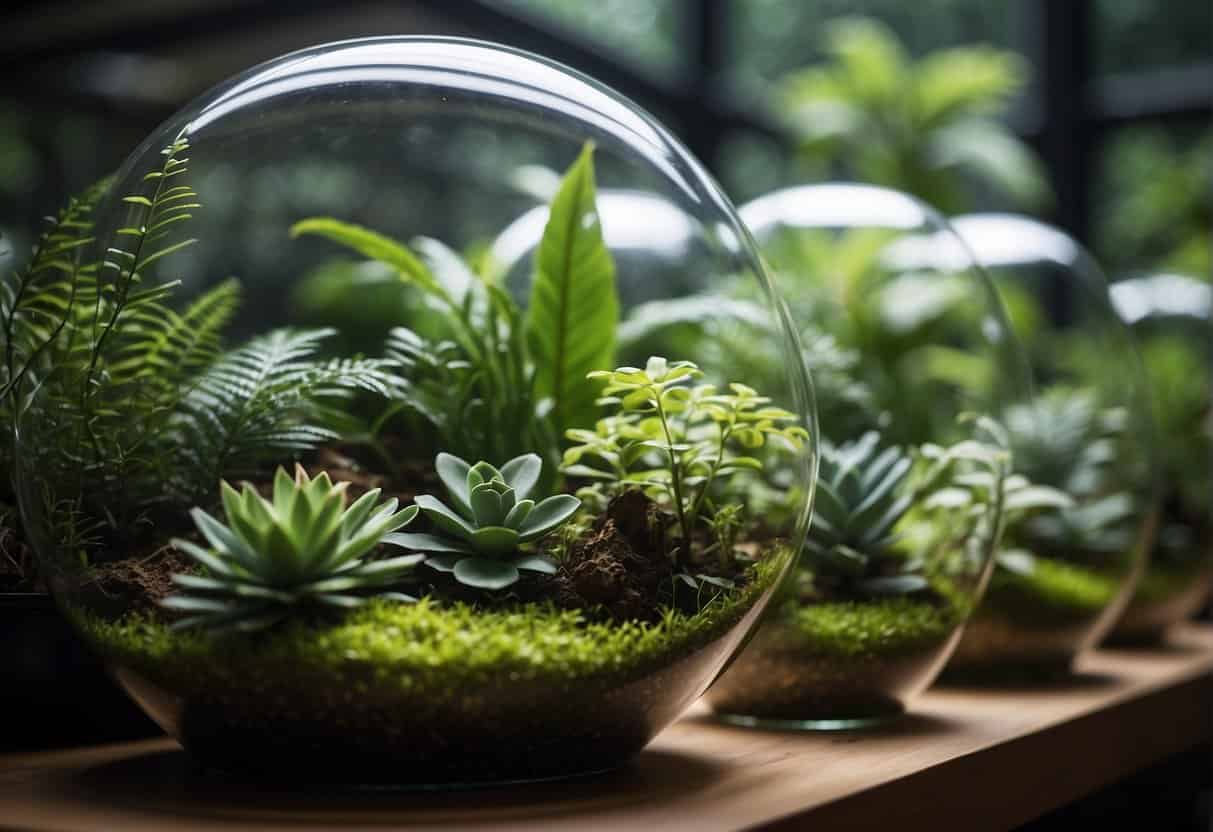
Creating a visually appealing terrarium requires careful attention to detail. From selecting the right container to arranging layers for practicality and beauty, each step is crucial for crafting a thriving miniature garden.
Layering and Aesthetics
A terrarium is not just about the greenery but also the layers that make up its foundation. Begin with a base layer of pebbles or small rocks to ensure proper drainage. Over this, add a layer of activated charcoal to keep the water fresh, followed by sand for additional drainage and to prevent soil compaction. Soil comes next, chosen specifically for the plants you intend to use. Each layer should be visually distinct to create visual interest and to support the health of the terrarium’s ecosystem.
Choosing the Right Container
When selecting a container, one has options ranging from simple glass bowls to elaborate geometric shapes. The container must suit the environment you wish to create; closed containers with a lid maintain higher humidity and are good for moisture-loving plants, while open containers are suitable for plants that prefer a dry climate. Glass containers are ideal as they allow for sufficient light penetration, essential for plant growth, and provide an unobstructed view of your greenery.
Adding Finishing Touches
The final touch involves adding elements such as mosses, figurines, or additional rocks to enhance the terrarium’s appearance, contributing to the overall aesthetic appeal. Carefully placing these elements to complement the plants ensures the creation of a balanced, living piece of art. The finishing touches should not overwhelm the plants but rather, integrate with the overall design to complement the greenery and visual interest of your terrarium.
Maintaining Your Terrarium

Creating a thriving terrarium requires understanding the balance of its ecosystem. Proper care ensures that your terrarium plants remain not only low-maintenance but also healthy and vibrant.
Routine Care and Maintenance
Watering: Terrariums usually need less frequent watering due to their contained environments. Key indicators of the need for water are dry topsoil and wilted leaves. For tropical terrarium plants, maintaining humidity is essential, which might translate to light watering once a week. For succulent-based terrariums, the watering requirements are even less, possibly bi-weekly or monthly.
Pruning: To maintain the aesthetic appeal and health of your terrarium, regular pruning is necessary. Remove yellowing leaves and trim back overgrowth to prevent it from overwhelming your setup. This maintains a controlled environment and encourages healthy growth habits.
Inspecting for Pests: Although a closed terrarium is a controlled environment, pests can still become an issue. Regularly inspect your plants for common pests like spider mites or fungus gnats. Early detection makes management easier and prevents them from becoming a larger problem.
Troubleshooting Common Issues
Mold: A common issue with terrariums is mold growth due to excess moisture. If you see white fuzzy growth, improve ventilation and reduce watering frequency.
Overwatering and Underwatering: Signs of overwatering include standing water at the bottom or mold growth. Underwatering presents as dry soil and wilted plants. To correct either issue, adjust your watering schedule accordingly, making sure to allow soil to dry out somewhat between watering sessions.
Propagation: When plants outgrow the terrarium or lose their low-maintenance nature, propagation might be required. Carefully remove the plant and separate it into smaller pieces to replant or start new terrariums.
Long-Term Success
A low-maintenance terrarium is designed to thrive with minimal intervention. To achieve long-term success, it’s vital to choose the right plants and understand their specific needs concerning watering, pruning, and the overall controlled environment. By setting a regular care routine and promptly addressing any issues, you ensure the health and beauty of your terrarium for years to come.
Expanding Your Knowledge

As you cultivate your terrarium, understanding different terrarium styles and plant care can greatly enhance your miniature garden experience. Expert resources and workshops can also provide invaluable guidance on your journey to becoming more adept in the art of terrarium gardening.
Inspirational Terrarium Styles
Exploring various terrarium styles can inspire enthusiasts to create unique and personalized miniature landscapes. Open terrariums are perfect for plants that prefer a dry climate, such as succulents and cacti, while closed terrariums create a humid environment suitable for humidity-loving plants.
Advanced Plant Care
A deeper understanding of plant care is crucial for maintaining a healthy terrarium. Specific houseplants used in terrariums, like the carnivorous Venus Flytrap, require particular attention to light and soil moisture. These specialized requirements are especially relevant for plants that thrive in high humidity conditions found within closed terrarium gardens.
Terrarium Workshops and Resources
For those looking to refine their green thumb, local gardening workshops and online resources can be a treasure trove of information. Workshops may cover topics such as selecting suitable plants for your terrarium, crafting a balanced miniature ecosystem, and even the proper techniques for planting and pruning. Resources such as Mindbodygreen provide expert advice on plant choices and design ideas, helping both novices and experienced gardeners develop their skills.
Essential Tools and Supplies

Creating a terrarium requires specific tools and materials that ensure the ease of assembly and sustainability of the plants within. Choosing the right supplies is crucial for both beginners and experienced enthusiasts.
Basic Tools for Beginners
For those starting out, a set of basic tools is indispensable for terrarium building. This includes:
- Tweezers: Often referred to as ‘The Grabber’, they allow precise placement of plants and decorations, especially in terrariums with narrow openings.
- Gloves: To protect hands from moisture and dirt, small gardening gloves are helpful.
- Scissors: Small and sharp scissors are necessary for trimming and shaping the plants.
These tools assist in creating a hospitable environment for the chosen greenery without difficulty or mess.
Selecting Quality Materials
The longevity of a terrarium greatly depends on the materials used:
- Activated Charcoal: This layer is essential in preventing mold growth by purifying water within the ecosystem.
- Substrate: A quality substrate ensures proper drainage and supports the roots of the plants.
- Terrarium Containers: The clarity and shape affect both the health of the plants and the display quality.
When selecting plants, it’s important to choose varieties that thrive in the unique microclimate of a terrarium such as ferns or mosses. These suitable plants typically prefer humid conditions and can flourish in the indirect light that a terrarium provides.
Frequently Asked Questions

When crafting a low-maintenance terrarium, the selection of plants and their arrangement play crucial roles in minimizing care and ensuring long-term success. Here are some common queries addressed to help you construct your own self-sustaining miniature garden.
What are the best plants to use for low-maintenance, small-sized terrariums?
Ideal plants for small terrariums that require minimal upkeep are mosses, air plants, and succulents. They tolerate humid conditions well and can adapt to the compact spaces of mini terrariums. Succulents like haworthias and echeverias are especially popular for their low water requirements.
Where can I find miniature plants that are suitable for terrariums?
Miniature plants can be found at garden centers, specialty stores, or online nurseries. Look for vendors that offer terrarium-specific varieties, ensuring that the plants you purchase are intended to thrive in terrarium environments.
Could you suggest some creative ideas for terrarium plant arrangements?
Consider layering different textures and heights by combining plants like ferns, peperomias, and ivies. Incorporate decorative elements like small stones or figurines to add personality and visual interest to your terrarium.
What components are included in a terrarium plant kit and how do they simplify setup?
A terrarium plant kit typically contains the necessary components, such as substrate, charcoal, decorative elements, and of course, plants. These kits streamline the assembly process, making it easy for anyone to start a terrarium without having to source materials individually.
Are there specific tropical plants that thrive in terrarium environments with minimal care?
Yes, tropical plants like nerve plants, philodendrons, and small species of ferns thrive in the humid, warm conditions of terrariums. These plants generally require less care, as the terrarium’s controlled environment closely mimics their natural habitat.
Which plants should I consider for terrariums that receive little to no natural light?
For terrariums in low-light conditions, choose plants like mosses, spider plants, and pothos. These plants are known for their ability to thrive in reduced light and can maintain their vibrancy even when sunlight is scarce.


